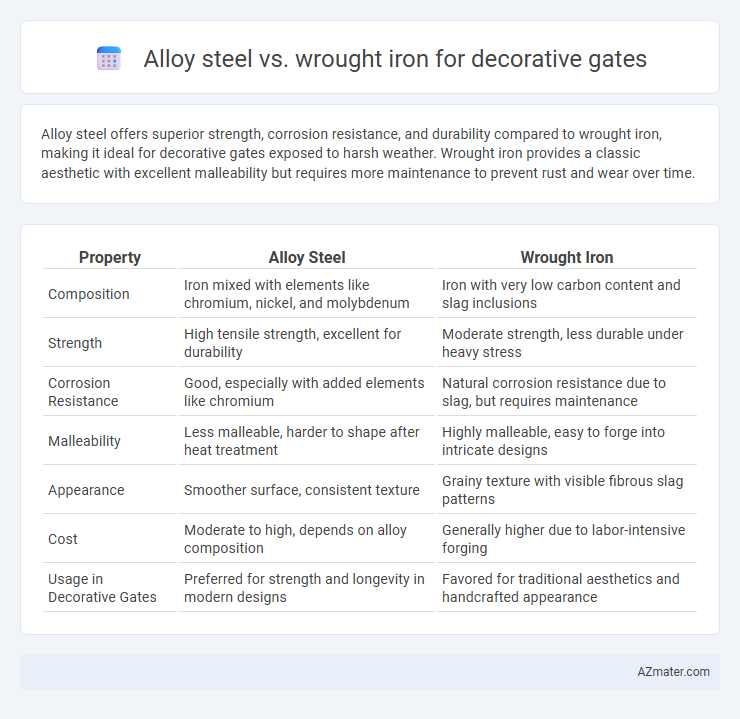Alloy steel offers superior strength, corrosion resistance, and durability compared to wrought iron, making it ideal for decorative gates exposed to harsh weather. Wrought iron provides a classic aesthetic with excellent malleability but requires more maintenance to prevent rust and wear over time.
Table of Comparison
| Property | Alloy Steel | Wrought Iron |
|---|---|---|
| Composition | Iron mixed with elements like chromium, nickel, and molybdenum | Iron with very low carbon content and slag inclusions |
| Strength | High tensile strength, excellent for durability | Moderate strength, less durable under heavy stress |
| Corrosion Resistance | Good, especially with added elements like chromium | Natural corrosion resistance due to slag, but requires maintenance |
| Malleability | Less malleable, harder to shape after heat treatment | Highly malleable, easy to forge into intricate designs |
| Appearance | Smoother surface, consistent texture | Grainy texture with visible fibrous slag patterns |
| Cost | Moderate to high, depends on alloy composition | Generally higher due to labor-intensive forging |
| Usage in Decorative Gates | Preferred for strength and longevity in modern designs | Favored for traditional aesthetics and handcrafted appearance |
Introduction to Decorative Gate Materials
Alloy steel offers enhanced strength, corrosion resistance, and versatility compared to wrought iron, making it a preferred choice for decorative gates that require durability and intricate designs. Wrought iron, known for its classic appearance and malleability, remains popular for traditional and ornamental gates but requires regular maintenance to prevent rust. Selecting between alloy steel and wrought iron depends on balancing aesthetic preferences, structural integrity, and long-term upkeep demands for decorative gate materials.
Overview of Alloy Steel
Alloy steel, composed of iron with added elements like chromium, nickel, and molybdenum, offers superior strength and corrosion resistance compared to wrought iron, making it ideal for decorative gates exposed to harsh weather. Its enhanced durability and hardness ensure long-lasting structural integrity while allowing intricate designs through advanced fabrication techniques. Alloy steel gates require less maintenance and provide better resistance to rust, increasing their lifespan and aesthetic appeal in outdoor settings.
Overview of Wrought Iron
Wrought iron is a traditional material known for its malleability, corrosion resistance, and classic aesthetic, making it a popular choice for decorative gates. It contains very low carbon content, which allows for intricate designs and superior weldability compared to alloy steel. Wrought iron's durability and ability to withstand outdoor weather conditions without rusting easily make it ideal for long-lasting ornamental gates.
Strength and Durability Comparison
Alloy steel offers superior strength and corrosion resistance compared to wrought iron, making it a more durable choice for decorative gates exposed to weathering. Wrought iron, while historically popular for its malleability and classic aesthetic, tends to be softer and more prone to rust without regular maintenance. The enhanced tensile strength of alloy steel extends the gate's lifespan, reducing the need for frequent repairs or replacements in outdoor environments.
Aesthetic Appeal and Design Flexibility
Alloy steel offers superior aesthetic appeal for decorative gates with its ability to be precisely crafted into intricate, modern designs due to its enhanced malleability and strength. Wrought iron provides a classic, timeless look with natural textures and hand-forged patterns, appealing to traditional and ornate design preferences. The design flexibility of alloy steel surpasses wrought iron by accommodating complex shapes and innovative architectural elements without compromising durability.
Corrosion Resistance and Maintenance
Alloy steel offers superior corrosion resistance compared to wrought iron, making it a preferred choice for decorative gates exposed to varying weather conditions. Its enhanced durability reduces the need for frequent maintenance such as repainting or rust removal, ensuring a longer lifespan and sustained aesthetic appeal. Wrought iron, while traditionally favored for its classic look, requires more regular upkeep to prevent rust and maintain its structural integrity.
Cost Factors and Budget Considerations
Alloy steel gates typically offer higher strength and corrosion resistance but come at a greater initial cost compared to wrought iron, which is generally more affordable and easier to work with for intricate designs. Budget considerations should account for alloy steel's longer lifespan and lower maintenance expenses, potentially offsetting its upfront price over time. Wrought iron remains a cost-effective choice for decorative gates when prioritizing initial installation cost and traditional aesthetics.
Fabrication and Installation Differences
Alloy steel offers higher tensile strength and better weldability compared to wrought iron, making fabrication faster and more precise for decorative gates. Wrought iron requires more labor-intensive forging and riveting, resulting in a longer installation process due to its heavier weight and less uniformity. Installation of alloy steel gates is simplified by its consistent composition and lighter weight, allowing for easier cutting and fitting on-site.
Longevity and Value Over Time
Alloy steel offers superior longevity for decorative gates due to its enhanced strength and corrosion resistance compared to wrought iron, which is prone to rust and requires frequent maintenance. Over time, alloy steel gates maintain their aesthetic appeal and structural integrity, delivering better value by reducing repair and replacement costs. The initial higher investment in alloy steel is offset by its durability and lower upkeep, making it a cost-effective option for long-term use.
Choosing the Right Material for Your Decorative Gate
Alloy steel offers higher strength, corrosion resistance, and durability compared to wrought iron, making it ideal for decorative gates exposed to harsh weather conditions. Wrought iron provides a classic, ornate appearance and is easier to weld and repair, suitable for traditional or vintage-style designs. Selecting between alloy steel and wrought iron depends on factors such as desired gate longevity, maintenance requirements, and aesthetic preferences.

Infographic: Alloy steel vs Wrought iron for Decorative gate
 azmater.com
azmater.com